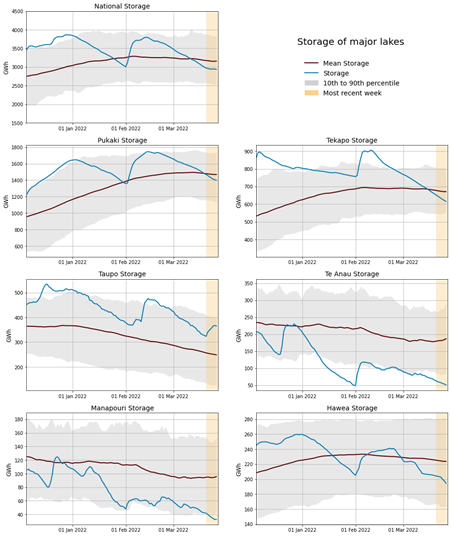Eye on electricity
Hydro storage: the lowdown
- Generation
- Prices
On 29 March, the Authority published an article on the current state of forward prices.
This update provides more detail on one of the contribution factors and looks at how low inflows in early 2022 and current very low levels of some of New Zealand’s major lakes are impacting forward price expectations.
A picture of decline
The graphs below show the national situation, as well as storage of individual hydro schemes alongside their historical means and 10th to 90th percentile. The yellow indicates the most recent week.
Nationwide hydro storage has been trending downwards from 13 February 2022 with all major lake levels decreasing. This extended trend of decreasing storage has been due to historically low inflows in later 2021 and early 2022 and has increased the opportunity cost of hydro generation as a result with generators likely wanting to conserve water ahead of winter and gas outages.
But the storage story differs across the North and South
As the graphs show, there is a large imbalance in storage between lakes. Except for Manapōuri and Te Anau, all lakes were above their historical average on February 23 – helped by large rainfall events in early February. It was a different story a month later. By 27 March, all the Southern Lakes had fallen below their historical average.
What’s going on at Manapōuri and Te Anau?
Lake Manapōuri levels began dropping significantly in late January. By 30 January 2022 Manapōuri hit its low operating range which meant drawn down could not exceed 5 cm per day. Meridian subsequently withdrew Manapōuri capacity from the market to maintain full control over draw down of the lake.
Manapōuri storage continues to fall due to below average rainfall in the South. This is contributing to potential power quality issues in the lower South Island.
Lake Te Anau storage has also been dropping since the beginning of 2022, going below its 10th percentile and low operating range in January. Maximum draw down for Lake Te Anau while in its low operating range is 3 cm per day.
Meridian published an update on 30 March about the decreasing levels at Lake Te Anau and Lake Manapōuri and proposed action specifically targeted to slow down the drawdown level of Lake Te Anau.
Northern lakes are in better shape
Lake Taupo levels were aided by heavy inflows in late March, which boosted storage to close to its historical 90th percentile.
The Authority is keeping a close eye on the hydro situation and continues to communicate regularly with generators.

Related News
Centralised wind and solar forecaster contract awarded
The Electricity Authority has awarded a contract to provide centralised wind and solar forecasting services to DNV Services.
Battery energy storage systems roadmap released
We have published a draft two-year roadmap that sets out our work to support investment in battery energy storage systems (BESS). BESS will become increasingly…
An explanation of ASX forward prices
In 2022 we published an article that looked into how the ASX forward electricity market works and the factors that affect these prices. This article looks at s…